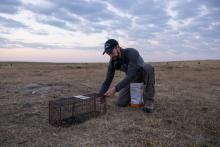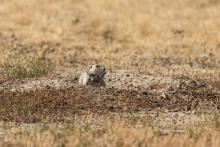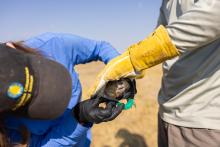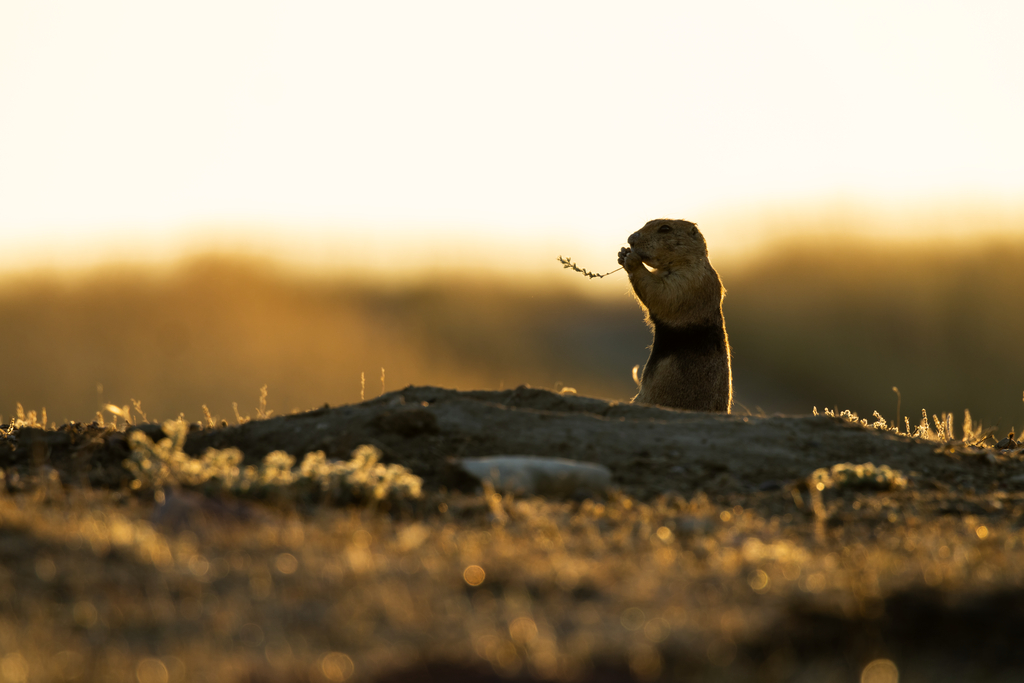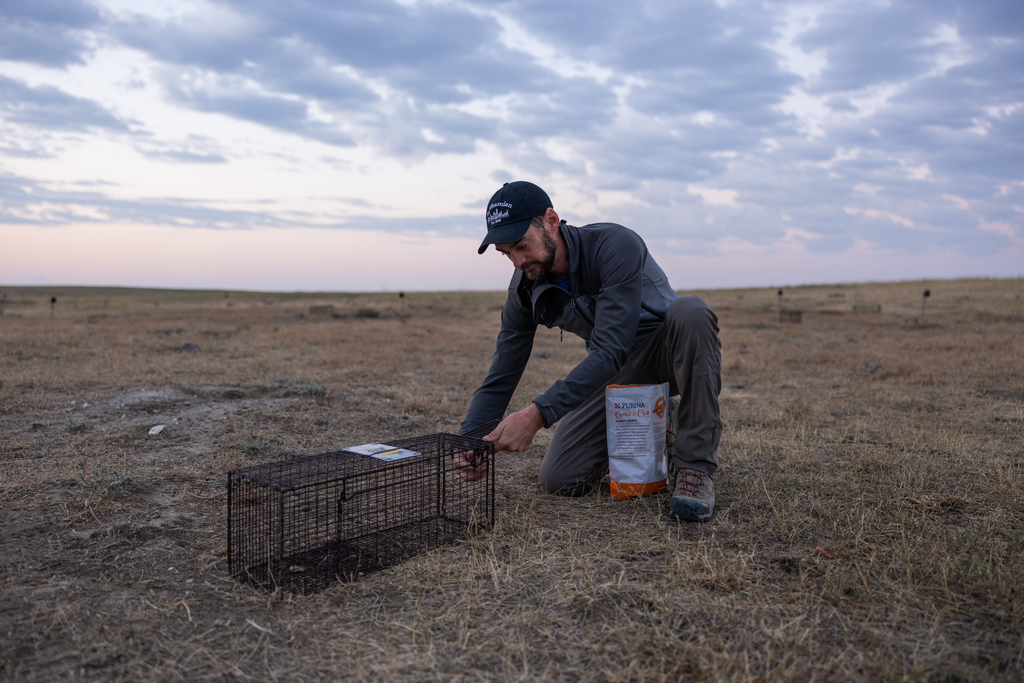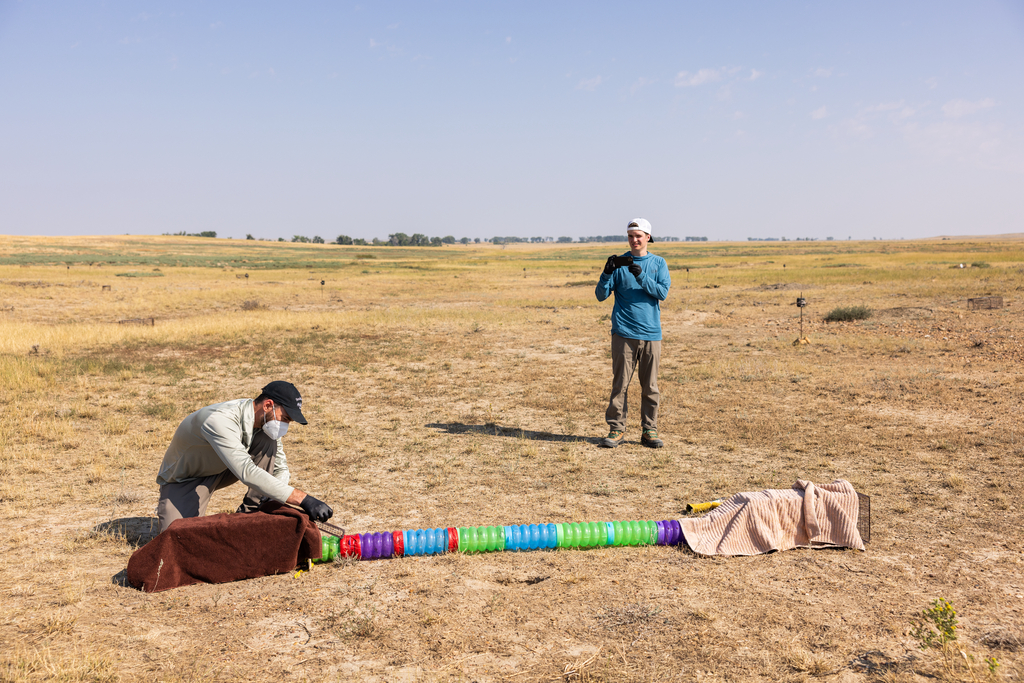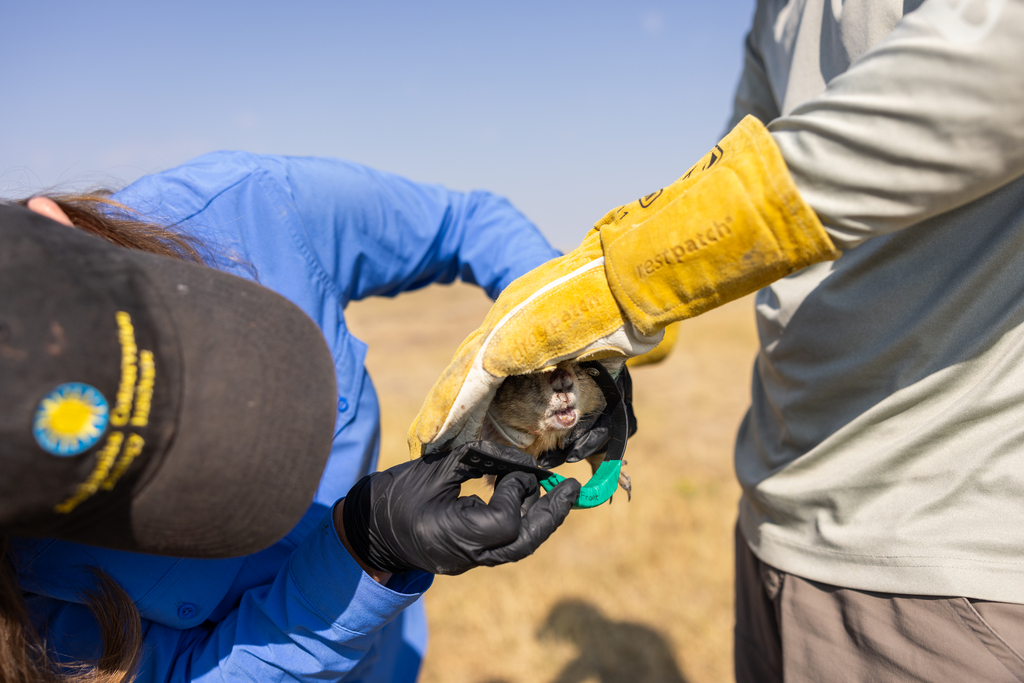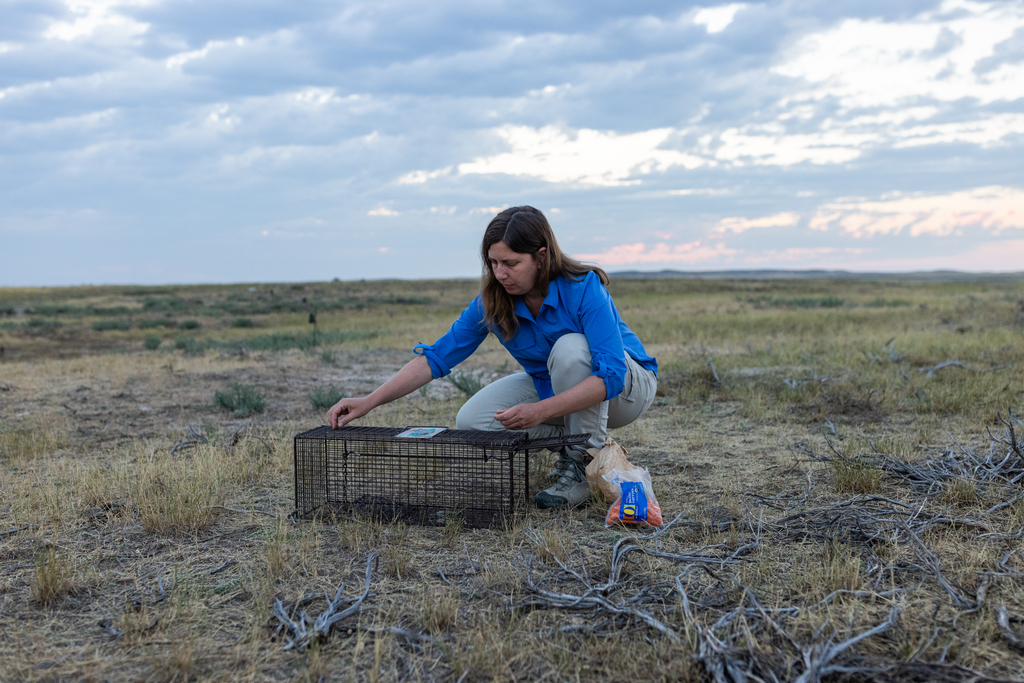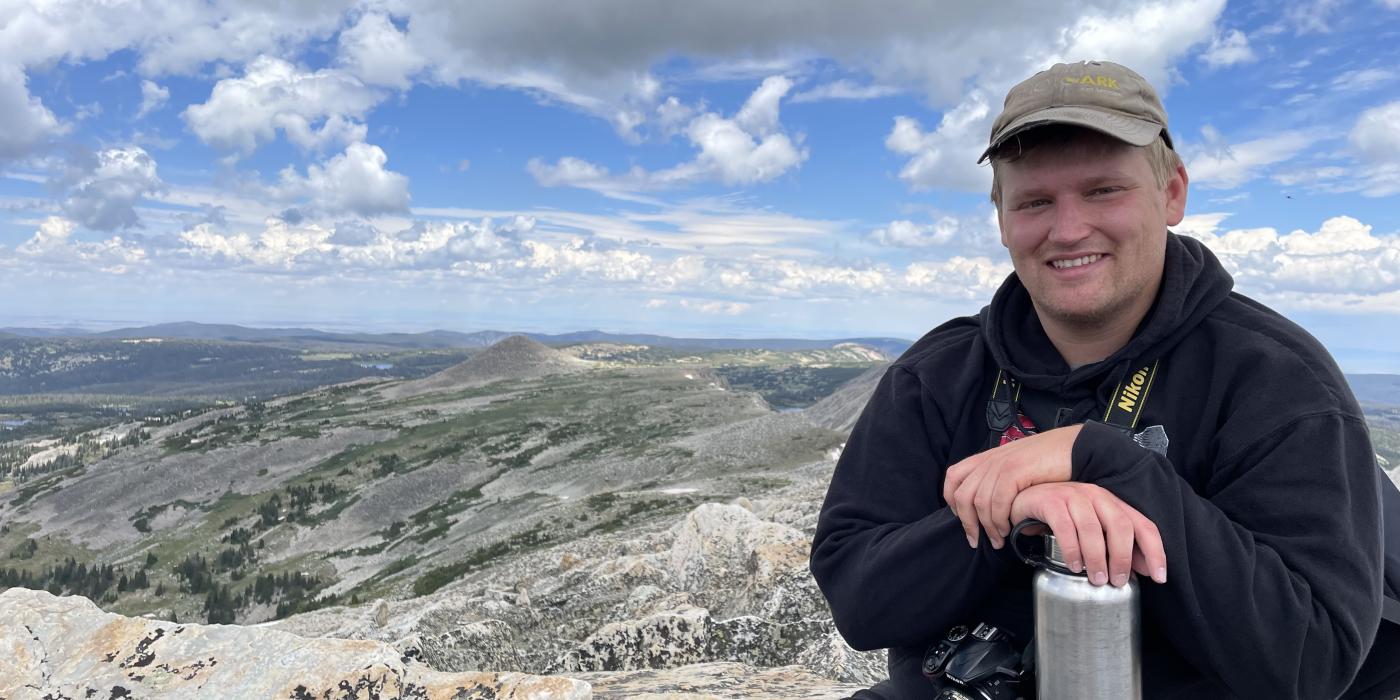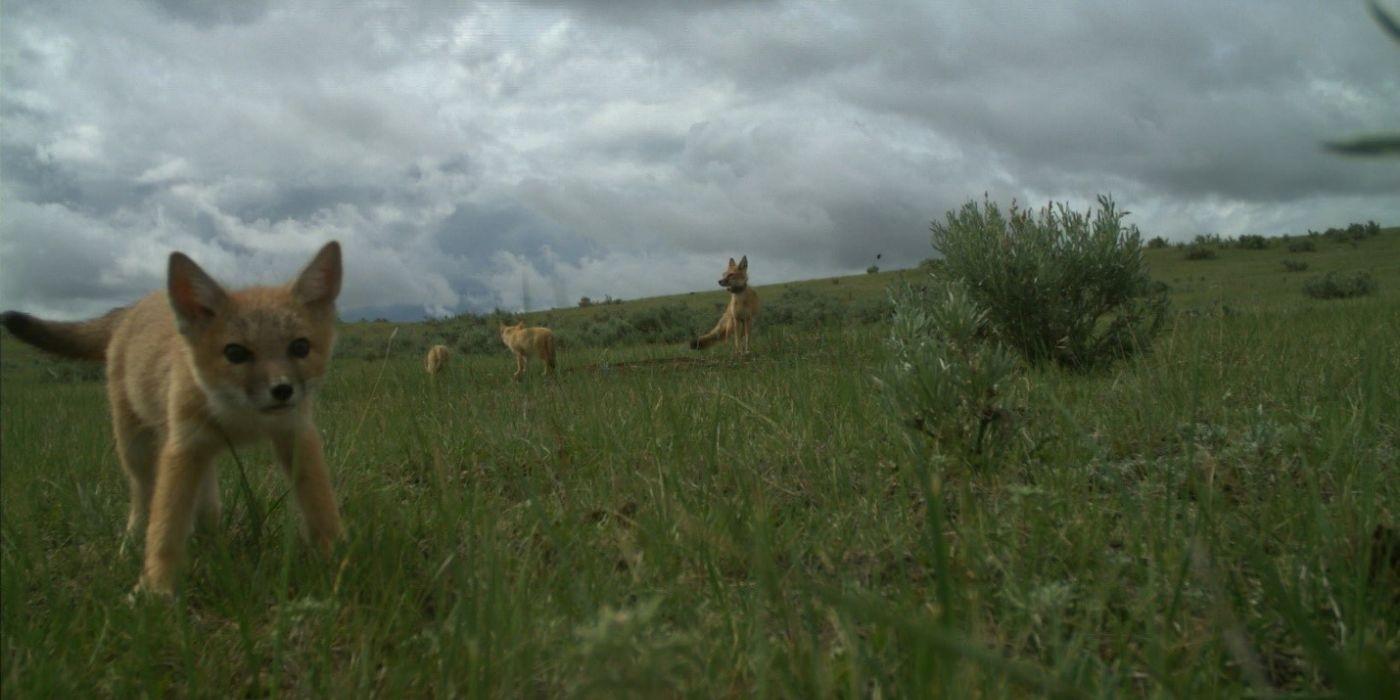New Technologies Track Prairie Dogs and Map Their Burrows for the First Time
Insights Could Help Save North America’s Endangered and Only Native Ferret Species
The Smithsonian’s National Zoo and Conservation Biology Institute (NZCBI) Great Plains Science Program team, in collaboration with project partners American Prairie, Fort Belknap Fish and Wildlife Department, U.S. Fish and Wildlife Service (USFWS) and Swansea University, have successfully deployed new groundbreaking movement tracking devices that will provide vital insights into the lives of endangered black-footed ferrets and their prairie dog prey belowground for the first time in history.
Long considered a pest, prairie dogs are a keystone species and ecosystem engineer that support more than a dozen other species by providing a source of food and shelter. This includes the black-footed ferret whose diet consists almost entirely of prairie dogs. Ferrets also make their homes in the complex and extensive prairie dog burrows. Sylvatic plague, a disease spread by fleas, is deadly to both ferrets and prairie dogs, and has drastically reduced prairie dog populations throughout North America.
“This technology has the potential to open a new window into the lives of two iconic prairie species and could revolutionize our understanding of their biology and ecology and the ecosystem as a whole,” said Hila Shamon, co-leader of the project and a research ecologist with NZCBI. “That kind of deep understanding of how these animals utilize their underground habitat is essential for continued prairie dog and black-footed ferret recovery efforts.”
While GPS trackers have provided invaluable data for many terrestrial species, in this case, the technique is not practical by itself because the GPS cannot receive information from satellites while underground. To get around this issue, Shamon and colleagues worked with Rory Wilson and James Redcliffe from Swansea University’s Department of Biosciences to utilize a device developed by WildBytes Technologies called Daily Diaries, which could help researchers understand how fossorial (burrowing) animals behave and use space underground. When combined with a traditional GPS tracker, data collected by the Daily Dairies is used to reconstruct the tagged animal’s movements while underground. As the critter plunges into a burrow, the Daily Diaries tag uses multiple sensors, including an accelerometer and a magnetometer, to record the relative speed and in which directions the animal moves. The path of the underground movements are then calibrated with aboveground locations collected by the GPS, which reveals the animal’s location when it pokes its head up aboveground using a triangulation method. The animal’s path is then plotted between those two known aboveground points in 3D, providing researchers with information on a fine scale.
Researchers collared seven wild prairie dogs to map underground pens during captive trials in June at the USFWS National Black-footed Ferret Conservation Center in Colorado. Using the data from the Daily Diaries, the team created 3D renderings of the animals’ paths as they moved through the burrow system, with discernable variations in movement speed. Combined with knowledge of prairie dog behavior, the new tracking collars will allow researchers to learn about several key components of prairie dog ecology, including the prairie dogs’ activity budgets in their underground habitats.
“This new data will help us gain insights into their behaviors underground, such as how much time these animals spend in different parts of the burrow system and how they move between burrows,” said Jesse Boulerice, an NZCBI ecologist on the project team. “These data could help our understanding of habitat use and survival, while also informing plague mitigation strategies.”
With successful captive trials completed, scientists moved on to field trials at American Prairie in northeastern Montana from Aug. 21 to Aug. 25 during which the team collared an additional 23 wild prairie dogs. The data gathered are still being analyzed.
“American Prairie’s mission to rewild a portion of the Northern Great Plains depends on the recovery of keystone species like prairie dogs,” said Daniel Kinka, senior wildlife restoration manager of American Prairie. “The better we understand their lives underground, the better we can restore their vital role in the ecosystem.”
Just as huge herds of bison once roamed the plains, prairie dogs used to live on enormous swaths of grassland in numbers more like cities than towns. The conversion of prairie to farms destroyed their habitat, and systematic poisonings removed colonies from land set aside for cattle. Sylvatic plague, spread by fleas, drove further declines in the wild populations. Over time, prairie dog numbers dropped by more than 95%. Their story represents more than just the loss of one species; it also accelerated the decline of the suite of species supported by prairie dog engineering.
Black-footed ferrets once ranged across the western plains but were thought to be extinct until a small population was discovered Sept. 26, 1981, near Meeteetse, Wyoming. All black-footed ferrets today—in human care and in the wild—are descendants of the 18 individuals brought into human care by USFWS and the Wyoming Game and Fish Department to create a captive breeding and reintroduction program with the goal of preventing species extinction.
Currently, there are approximately 280 black-footed ferrets at captive breeding facilities, including at NZCBI, which has participated in the cooperative breeding program since 1988. Smithsonian scientists have helped increase the genetic diversity in the black-footed ferret population using artificial insemination and cryopreserving sperm. As of 2022, the USFWS breeding and reintroduction program has resulted in more than 7,000 black-footed ferret kit births across six zoos and more than 2,600 of those animals being reintroduced into the wild. These recovery efforts are managed by the USFWS National Black-Footed Ferret Conservation Center and partners in multiple states.
The Tribes of Fort Belknap Indian Community in Montana are leaders in wildlife restoration to the Great Plains. Black-footed ferrets—first reintroduced to the Fort Belknap Reservation in 1997 as part of the USFWS program—are one of several iconic prairie species recovered to native lands, including buffalo, sage-grouse, prairie dogs and swift foxes.
“Our people have lived alongside our animal relatives for tens of thousands of years,” said Harold “Jiggs” Main, director of Fort Belknap Fish and Wildlife Department. “We now have an important role to help restore the balance in the ecosystem by helping bolster native species population. These are decades-long efforts and research like this will support our management of prairie dogs and black-footed ferret recovery.”
Made possible by a grant from the Paul G. Allen Family Foundation, this project is led by NZCBI with support from partners Fort Belknap Indian Community, American Prairie and Swansea University. An advisory group includes World Wildlife Fund, Defenders of Wildlife, USFWS and experts from the Black-Footed Ferret Recovery Implementation Team.
“The foundation recognizes the critical importance of protecting endangered species like the black-footed ferret and preserving the delicate balance of ecosystems,” said Yuta Masuda, science director of the Paul G. Allen Family Foundation. “By harnessing cutting-edge technologies and innovative tracking methods, this project has the potential to work with communities and partners to contribute to the survival of both the black-footed ferret and its crucial prairie dog prey. We are excited to see the outcomes of this multi-year endeavor.”
NZCBI’s Great Plains Science Program (GPSP) works to understand, restore and preserve this vital and imperiled ecosystem. Through sound science, education opportunities and in partnership with current and expanded rightsholders and stakeholders, the Smithsonian continues its efforts to understand how the Great Plains ecosystem is responding to both anthropogenic change, climate change, grassland restoration and rewilding efforts presently and into the future.
Project Partners
The Smithsonian’s National Zoo and Conservation Biology Institute (NZCBI) leads the Smithsonian’s global effort to save species, better understand ecosystems and train future generations of conservationists. Its two campuses are home to more than 2,100 animals, including some of the world’s most critically endangered species. Always free of charge, the Zoo’s 163-acre park in the heart of Washington, D.C., features 2,100 animals representing 400 species and is a popular destination for children and families. At the Conservation Biology Institute’s 3,200-acre campus in Virginia, breeding and veterinary research on 250 animals representing 20 species provide critical data for the management of animals in human care and valuable insights for conservation of wild populations. NZCBI’s 305 staff and scientists work in Washington, D.C., Virginia and with partners at field sites across the United States and in more than 30 countries to save wildlife, collaborate with communities and conserve native habitats. NZCBI is a long-standing accredited member of the Association of Zoos and Aquariums.
American Prairie’s mission is to create the largest nature reserve in the contiguous United States, a refuge for people and wildlife preserved forever as part of America’s heritage. In service of that mission, the American Prairie ecosystem will contain ecologically meaningful populations of all non-extinct and endemic species present in the reference ecosystem, with management focused on maximizing the integrity, complexity and resilience of the system.
Fort Belknap Fish and Wildlife Department has successfully returned the endangered black-footed ferret and Plains bison to the Fort Belknap Indian Community lands and has recently initiated a swift fox reintroduction project in cooperation with Smithsonian scientists. The federally recognized Gros Ventre (Aaniiih) and Assiniboine (Nakoda) Tribes (Tribes) manage 675,000 acres of land in Montana, which provides critical habitat for some of Montana’s most treasured and rare species. The Tribes are committed to conserving native species and their habitats on the Fort Belknap and preserving and protecting the cultural values of the Fort Belknap Indian Community.
Founded in 1920, Swansea University is a research-led, dual campus university located along Swansea Bay in south Wales, UK. Its stunning beachfront campuses and friendly welcome make Swansea University a desirable destination for more than 22,000 students from across the globe. There are three academic faculties, delivering around 450 undergraduate and 350 postgraduate degree programs.
Founded in 1920, is a research-led, dual campus university located along Swansea Bay in south Wales, UK. Its stunning beachfront campuses and friendly welcome make Swansea University a desirable destination for more than 22,000 students from across the globe. There are three academic faculties, delivering around 450 undergraduate and 350 postgraduate degree programmes.
Swansea is a UK top-30 institution, ranked 25th in the 2024 Guardian University Guide. In the 2021 Research Excellence Framework, 86% of Swansea University’s overall research and 91% of its research environment were classed as world-leading and internationally excellent, with 86% of its research impact rated outstanding and very considerable.
Project Funder
Paul G. Allen Family Foundation
Founded in 1988 by philanthropists Jody Allen and the late Paul G. Allen, co-founder of Microsoft, the foundation supports a global portfolio of nonprofit partners working across science and technology solutions to protect wildlife, preserve ocean health and create lasting change. The foundation also funds the Paul G. Allen Frontiers Group, which works to advance cutting-edge research in all areas of bioscience. Learn more at www.pgafamilyfoundation.org.
# # #
Image Gallery

